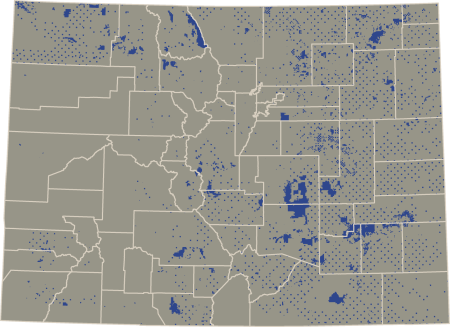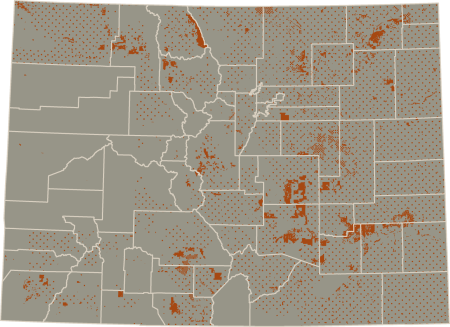Severed estate
The State Land Board owns 2.8 million acres of surface (pictured in blue) and 4 million acres of sub-surface mineral estate (pictured in orange). When ownership of surface land and the underlying mineral estate differs, it's called severed estate.
Q&A
People often have questions about severe estate on their personal property. Here are answers to questions we are commonly asked.
Records related to the property in question are kept in the county clerk and recorder's office where the property is located (i.e. if your property is in Weld County, records related to that property are recorded at the Weld County Clerk and Recorder's Office). Searching through recorded documents can be complex and mineral title can be even more so. The Staff at the Clerk and Recorder's Office can assist with how to look up records but does not interpret documents that are recorded. Therefore, if you are unfamiliar with searching property title, hiring a landman or a mineral title attorney may be your best option to assist in determining ownership of mineral rights.
There is no requirement for a mineral owner or a lessee of a mineral owner to notify the surface owner if a lease is executed. Sometimes, either the mineral owner or the lessee will record the lease in the County Clerk and Recorder's office in order to put the public on notice - but there is no requirement for that to happen. Surface owners typically aren't entitled to notice until actual development is anticipated.
Under current State rules, any oil and gas development is regulated by the Colorado Oil and Gas Conservation Commission (COGCC). The COGCC rules specify how close development can get to a building unit, and typically that is no closer than 2,000 feet. Owners can sign waivers to allow development closer to the home, but an operator cannot require a waiver by an owner.
Development timing can be highly variable. Sometimes, even when property is leased - or even permitted for a well - development will never occur. A good way to see what is going on nearby would be to check the ECMC's map server to see where wells are being drilled. If activity is happening nearby, sometimes new permits or a pattern of development may indicate if new activity will occur soon.
In Colorado the mineral owner is considered dominant and has a legal right to reasonably access their minerals. The State Land Board can evaluate the mineral potential under your parcel to see if there is a risk of development. Surface owners can also pay a fee and obtain a twenty year No Surface Occupancy (NSO) Agreement with the State Land Board which prevents the State Land Board from using the surface estate to extract minerals. Please contact Ben Teschner the Solid Minerals Manager (benjamin.teschner@state.co.us) if you are interested in obtaining a NSO.
Accommodation Statement
The State of Colorado is committed to providing equitable access to our services to all Coloradans. Please contact Rachel Majich (rachel.majich@state.co.us or 720-854-3306) for personalized accessibility assistance using this page, which includes links to visual geographic representation of our data. The data is available in a text format upon request. We will contact you directly within three business days. Visit our accessibility webpage for more information and services, including AIRA, our free service for blind and low-vision users.

